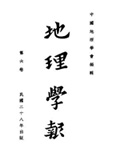LAU TUNG-MOR
During the summer of 1956, the writer had an opportunity to travel along the Wu-Ting-Ho Valley from the lower reaches right up to its headwaters, and some interesting but perplexing geo-morphological features were observed. This short paper is being prepared with a view to throw some light on these problems. I. PHYSIOGRAPHIC PROBLEM AS REGARDS THE POST-PLEISTOCENE TERRACES There are a series of river terraces along the lower and middle Wu-Ting-Ho Valley and two of them are clearly recognizable, the lower one is at elevation of some 10 m, and the higher one some 30 m. above the river bed (see fig. 2). But three steps of terraces could be recognized above the confluence of Y?-Chi-Ho with the main stream; the lower one is about 4-5 m., the intermediate one 16 m, and the higher one 36-40m. above the river bed (see fig. 3). The alluvial deposit of the higher terrace possesses a remarkably different characteristics differing from that of the lower two by containing a few darkish thin-bedded peat in the loessic sandy loam and bearing evidence of a lacustrine deposit. The two lower terraces mentioned above could be correlated in physiographic stages throughout the western Shansi and Northern Shensi, but there can hardly find counterpart for the higher terrace seen along the middle reaches of the Wu-Ting-Ho above the confluence of Y?-Chi-Ho. By inves;igating the causes, it a found that the . strip along the middle reaches of the Wu-Ting- Ho above the confluence had probably been a water-ponded broad valley or a Iake during the period extending from the dose of the Chingshui stage (erosional) right through the Malan stage of upper Pleistocene (depositional) and thus the aeolian loess was impossible to fill up the lake as happened in the middle and lower of the river valley, but aggradated in the bottom and formed the so-called Sjarra-0sso-gol series. Probably owing to the tilting or warping of the Ordos platform a new cyde ("Pan-Chiao stage") began, and then the river was rejuvenated while the lake drained, resulting in the built-up of terraces. But, on account of the different process of deposition during the "Malan stage", one more step of terrace is found above the confluence of Y?-Chi-Ho with the main stream.
